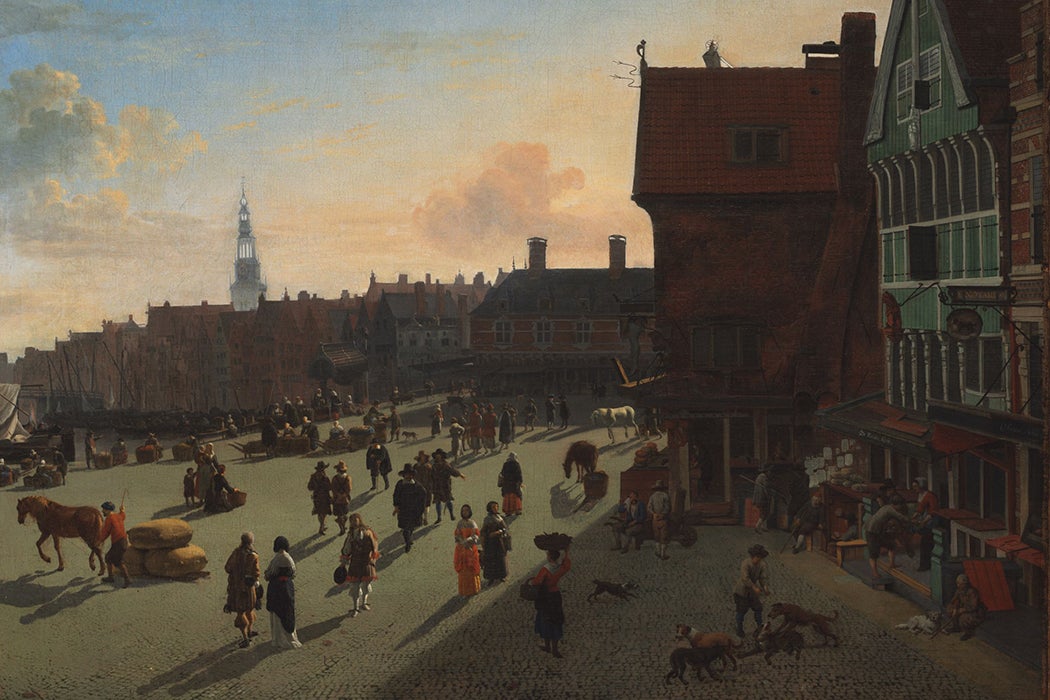Who says art can’t have real effects on the world? Seventeenth-century Amsterdam was the first city in Europe to have an efficient system of street lighting—and it was all due to a Golden Age painter called Jan van der Heyden.
The population of Amsterdam doubled over the course of the seventeenth century, from 100,000 in 1600 to 200,000 in 1670. This was the century when the iconic houses along the canals were built. It was also a time when dark streets were full of danger. In addition to high levels of crime, there were many cases of people falling into canals and drowning. To ensure public safety, the streets needed to be lit. This was a particularly difficult challenge at the time, since electricity did not yet exist.
In most medieval European cities, street lighting was either an act of charity (a candle placed before a church or holy relic) or a moving light carried by someone in the street. In Amsterdam this was true throughout the early modern age. Beginning in 1505 the law required anyone abroad after 9:00 p.m. to carry a lantern. In 1544, street lanterns were hung in the busiest streets. By 1579, lanterns were lit on bridges, and inns were obliged to keep a light in their front room until 10:00 p.m. In 1595, this was expanded to requiring every twelfth house on a street to hang out a burning candle housed in a lantern.
All of this was, however, very difficult to enforce. After all, wax candles were expensive and tallow candles burned out if the wick was not cut every few minutes. Night lantern lighters were appointed in 1597, but this was less than ideal. There were still many drowning deaths from falling into water at night, and the rattle watch (watchmen provided with rattles for sounding an alarm) had trouble performing their night duties with a rattle in one hand and a lantern in the other.
Jan van der Heyden, an artist whose paintings sold well, came up with a solution. As he specialized in painting buildings along the canal streets, he was keenly aware of the lighting problems. Additionally, he worked in his brother’s mirror shop and had invented the fire hose and other fire-fighting equipment. By the summer of 1669, he had perfected a municipal lighting plan burning oil rather than candles, which he gave to the Amsterdam mayors. The key materials were tin and glass, items familiar from the mirror shop. Van der Heyden recommended positioning the lights on every street and canal. What’s more, he offered to make all 1,800 lanterns himself. A true businessman, he added annual maintenance by himself for one year to his quote, extendable for twenty years.
In the end, a compromise was reached. Amsterdam gave van der Heyden the title Director of the Municpal Lights and a generous annual salary of 2,000 guilders, which he collected until his death in 1712.
Although his early lamps smoked and leaked, van der Heyden quickly improved his design. Since rising heat inside the lantern was a problem, he redesigned the specific shape of the glass and added air holes to encourage the smoke to escape efficiently and to consume less oil. Regarding the oil, he advised rapeseed oil from August to November and March to May, but linseed oil from December through February as it did not freeze. He controlled manufacture of the wicks himself, insisting on pure Cypriot cotton. He even mathematically calculated the spacing of lanterns every 125 to 150 feet for optimal lighting.
By 1670 Amsterdam boasted 1,800 street lamps, and by 1681 2,400 lamps. Adding all these lights was a colossal and expensive undertaking, and taxes in Amsterdam rose to pay for it. But seventeenth-century Amsterdam was already famous for its high municipal taxes. This new lighting system was so popular that cities across Holland, Europe, and eventually Japan, began to implement the same.







